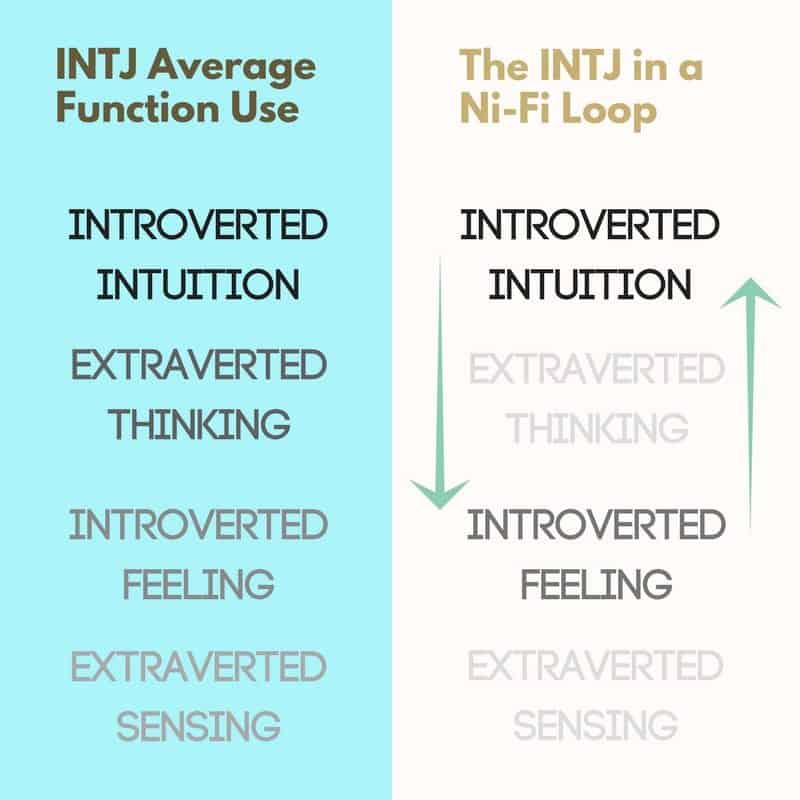Can Your Myers-Briggs® Personality Type Change?
Updated on May 29th, 2021
I get asked every day if someone can change their personality type. I come across people who say “I used to be an INFP, but now I’m an INFJ” or “I’m both an ISFP and an ESFP.” Is this possible? Can you change types or be two types? Let’s find out!

Not sure what your personality type is? Take our new personality questionnaire here. Or you can take the official MBTI® here.
This article contains affiliate links. If you purchase an eBook from one of my links I get a small percentage back to help run my site.
Table of contents
Estimated reading time: 10 minutes
Can Your Myers-Briggs® Personality Type Change Over Time?
According to Myers-Briggs theory, your personality type is inborn, and it doesn’t change. However, the way you exhibit your type WILL change (and should) as you go through life. Why? As you age and mature you develop different facets of your personality type.
Age and Your Cognitive Function Stack
Every personality type has a cognitive function stack. This stack includes four primary functions and four shadow functions – 8 functions total. As you go through life you’ll develop certain functions and enjoy them more than you did at other times in your life.
To explain, let’s use the example of an INTJ. Here is the INTJ function stack:
INTJ Primary Function Stack
Dominant Function: Introverted Intuition (Ni)
Auxiliary Function: Extraverted Thinking (Te)
Tertiary Function: Introverted Feeling (Fi)
Inferior Function: Extraverted Sensing (Se)
Shadow Functions:
Opposing Role: Extraverted Intuition (Ne)
Critical Parent: Introverted Thinking (Ti)
Trickster: Extraverted Feeling (Fe)
Demon: Introverted Sensing (Si)
When I took my MBTI® certification course I learned that the functions in our type mature at different periods of our lives. From birth to about age 7, the dominant function develops. So a very young INTJ would be wholly immersed in developing introverted intuition. We might not see much thinking, feeling, or sensing at a young age (although they would still be in use, just underdeveloped).
From 7 to age 20, the auxiliary function develops (as the dominant function continues developing). So at this age, we would see thinking start to develop more. The INTJ would become more objectively logical with their intuitions, more decisive, and organized.
During the 20s, 30s, and 40s, the tertiary function develops (as the dominant and auxiliary function continue developing). The INTJ would now start to become more concerned with discovering their individual ethics.
During the 50s, 60s and onward the inferior function (extraverted sensing) develops as the other functions continue developing. The INTJ would now be more tuned into the present, more detail-oriented, fonder of living in the moment and taking advantage of current opportunities.
How Age Impacts Your Perceived Personality
When I was doing my training to become an MBTI® practitioner, we were taught about how the different functions in our personality type evolve and grow throughout life.
If you are an introvert (like the INTJ we just discussed), you might feel more extraverted as you develop Extraverted Thinking or Extraverted Sensing. If you’re an extravert, you might feel more introverted as you develop your introverted functions. If you’re a sensor you might feel more connected to intuition as you develop intuition. If you’re intuitive you might feel more connected to sensing as you develop sensing. If you’re a thinker you might feel very in tune with feeling as that function develops, and vice versa.
So you may “feel” like a different type at different ages as you develop the lower functions in your stack. All the same, your dominant function will still be your dominant. No other function will have quite as much conscious power as that function. In the same way, your inferior will remain inferior, your auxiliary will remain in the support role, and your tertiary will remain the third-most potent function in your stack.
Here’s another example in case it’s still confusing. This time, we’ll use the ESFP as an example. Here is their primary function stack:
Dominant Function: Extraverted Sensing (Se)
Auxiliary Function: Introverted Feeling (Fi)
Tertiary Function: Extraverted Thinking (Te)
Inferior Function: Introverted Intuition (Ni)
Let’s imagine that we’re working with a 35-year-old ESFP. At this point in his life, he’s developing Extraverted Thinking, because that’s his tertiary function. He takes the Myers-Briggs® test and shows a strong preference for thinking because he’s really delving into that function right now. But when he reads the type descriptions he also feels a strong connection to the ESFP type. Which one is he? Is he a thinking type? Or is he an ESFP? Is he both? After more research, he realizes he identifies more with ESFP.
Confusion like this happens a lot, and it’s one of the reasons why learning about the cognitive functions is so important. If you know which functions you identify with and rely on more, then that will help you to define your type much more accurately than a simple test will.
How Dominant-Tertiary Loops Impact Your Perceived Personality
Dominant-tertiary loops occur when we bypass our auxiliary function and loop back and forth between our dominant and tertiary functions. There’s a strong temptation for all of us to enter these loops because the tertiary function has the same attitude as the dominant function.

What’s an attitude?
If you’re an introvert, your dominant and tertiary functions will be introverted.
If you’re an extravert, your dominant and tertiary functions will be extraverted.
Extraversion and introversion are attitudes. One’s energy flows inward (introversion), and the other’s energy flows outward (extraversion).
Why Do We Want to Enter Loops?
If you’re an introvert, you’ll always gain the most energy from remaining in the introverted attitude. If you’re an extravert, you’ll always gain the most energy from remaining in the extraverted attitude. The auxiliary and inferior functions can drain us sometimes because they have a different attitude than we prefer. For example, as an INFJ I often feel tempted to immerse myself wholly in intuition and thinking, because they’re both introverted for me (INFJs have introverted intuition and introverted thinking). Sometimes I don’t feel like embracing extraverted feeling (my auxiliary function) because it’s in my non-preferred attitude and doesn’t feel as “me” as intuition and thinking do. So if I get stuck in an intuition-thinking loop I might test as INTP or INTJ instead of INFJ. Or I might decide that I’m an INTJ and an INFJ (I’ve seen people do this).
But am I really two types? No. I’m just bypassing my auxiliary function and looping back and forth between intuition and thinking. Usually, this results in stunted development and warped perspectives. We need to develop both our introverted and extraverted functions, and when we don’t, we end up skewing our perspective of the world around us.
Extraverts in an extraverted loop become too hasty, too wrapped up in acting, doing, and interacting without reflecting and considering. Introverts in an introverted loop become too stuck in their own subjective world; they lose track of an objective focus or taking action on their ideas and perspectives.
The Tertiary Function and Mistyping
One of the other common reasons that people can identify with two types or mistype themselves is that they are drawn to their tertiary function. Most of us enjoy using our tertiary function; in fact, that’s why it’s called the “relief” function. The tertiary function provides relief and is a way that we tend to be creative and playful. This is why psychologist John Beebe called the tertiary function “the eternal child.” We often identify with the tertiary function in a deep way because it is in our preferred attitude (if we’re introverted, it’s introverted, etc,.) and also because we tend to get joy out of tinkering and engaging with this function in daily life.
For this reason, I see may ISXPs type as INJs. ISPs have tertiary introverted intuition so many times they will type as INTJs and INFJs instead of ISPs. I also see ESJs mistype as intuitives because they are developing intuition as their tertiary function and are therefore drawn to some intuitive ways of thinking. Sometimes INPs can mistype as ISJs when they’re developing introverted sensing.
In mid-life especially, many individuals can mistype as they develop their tertiary function. EFPs might type as ETJs, ENJs might type as ESPs, etc,.
Your tertiary function holds a lot of appeal in mid-life. You can find out what your tertiary function is here.
So if you’re unsure of your type, think about which function comes the most naturally, without even having to try. The tertiary function is fun and creative and playful, but it doesn’t function as smoothly and effortlessly as the dominant function does. It takes more conscious work to master.
The Judging/Perceiving Problem
Many, MANY introverts get mistyped because of the confusion over the J/P preference. The J/P preference tells us how we are oriented to the outer world, not how we are oriented internally.
Most descriptions of judging types will be relatable to EJ types, but less so to IJ types. In the same way, most descriptions of perceivers will be relatable to EP types, but less so to IP types.
Why is this?
IJ types have a dominant perceiving function. They are most content and most able to enter a “flow” state when they are in a mode of perception, not judgment (decision-making). IJ types can be surprisingly slow to make decisions, and they may prefer to leave things open-ended and ponder rather than act, decide, and organize. But because IJ types have an extraverted judging function, they are listed as “J”‘s because their first extraverted function is one of judgment, not perception.
If you’re confused you can read more about this here.
IP types also can mistype as IJ types because IP types (INFPs, ISFPs, INTPs, ISTPs) have a dominant judging function. Inwardly they might be much more decisive, firm on their opinions, and organized than they seem outwardly. But because their first extraverted function is one of perception, they are labeled as “P” types.
So it’s very common for IJ types to relate more to perceiver descriptions and IP types to relate to judging descriptions.
As Dr. AJ Drenth from Personality Junkie says, “IPs are a mix of J-P characteristics. Since their dominant function is a Judging function (Ti or Fi), they are inner Judgers. IPs are far more serious inwardly than they appear outwardly. Rather than remaining open to new information like healthy EPs, they feel driven to move toward closure and to have things settled in their minds like EJs. “
And in describing IJs, Drenth says: “IJs are also a mix of J-P characteristics. Outwardly, they look like Judgers. They can be assertive and opinionated, even resembling EJ types. But since their dominant function is a Perceiving function (Ni or Si), they are inner Perceivers. Indeed, they are dominant Perceivers. So in reality, IJs are far less serious, closed, or judgmental than they may appear outwardly.”
Wrapping It Up…
As you can see, there are a number of reasons that we can become mistyped or confused about which personality type is the best fit. But keep in mind that you do have just one personality type, but with many facets and dimensions that give you depth and variety. That’s a good thing! If you’re an ESTJ, for example, you still use intuition and feeling. If you’re an INFJ you still have perceiving and extroverted functions. Knowing the complexity of type helps us to appreciate the complexity of each individual we meet along the way!
What are your thoughts?
Has this been helpful? Has it confused you even more? Do you have any thoughts you’d like to add? Let us know in the comments! Find out more about your personality type in our eBook, Discovering You: Unlocking the Power of Personality Type.
References:
Are Personalities Permanent? Can Your Personality Type Change
MBTI® Manual – A Guide to the Development and Use of the Myers-Briggs Type Indicator® Instrument (CPP, Inc., 2009)
Rethinking Judging and Perceiving in Introverts – Personality Junkie

Other Articles You Might Enjoy:
Can Childhood Trauma Impact Your Personality Type?
Are Feelers More Emotional Than Thinkers?
Are Certain Personality Types Smarter Than Others?
A Beginner’s Guide to Identifying Someone’s Myers-Briggs® Personality Type

Subscribe to Our Newsletter

Want to discover more about personality type? Get the inside scoop with Susan Storm on all things typological, along with special subscriber freebies, and discounts on new eBooks and courses! Join our newsletter today!











it is NOT true that the type can’t change.
Because of 3 reasons.
1.) It is DIMENSIONAL. That means that no one is 100 percent one type. It is a tendency. For instance I am about 78% I, 86% N, 74% T and 89% P.
2.) The population is distributed in a gauß-shape in each dimension, meaning that most people have a rather small tendency in some dimensions (closer to 50%)) and maybe stronger tendency in other dimensions (farther from 50% though with decreasing likelihood towards 100%). This has already been shown in studies for the first dimension introverted-extraverted: there are many ambiverts.
3.) As in most cases it is both: nature and nurture. I estimate that we have about 30% room to move, so about 15% in one direction (say introverted) and 15% to the other (say extraverted), depending on the circumstances. But our personal zero point is given genetically. For instance let’s suppose my zero point for the first dimension is the actual 74% (you can’t really know, just estimate). So I could possibly change to states between 74+15=89% thinking to 74-15=59% thinking.
Deriving from 2 and 3: depending on the personal given zero point in each dimension (which is for most people distributed around 50% of some of the 4 dimensions because of the gauß-shape) and the pulling factors from our surrounding, it is POSSIBLE to change type – within approximately 30% of latitude. For instance a maximum change from 65% introverted to 65% extraverted is possible, though less likely than a change from 53% introverted to 53% percent extraverted. A change from 70% thinking to 70% feeling is not possible (that would be 40% difference).
No, typing by letters is unreliable and confusing. It is much better to study the cognitive functions, like the author suggests in this article.
THANK YOU for writing this article! I have been hurt and confused this year as I try to regain some personal space for myself in relationships and my life, but I keep getting confused by sensing that I’m picking up on now (I am 32). My family decided to try a new test on another site for fun recently and whan I got my results I came up with sensing instead of intuitive as I’d done in years past. I actually had family members take the test for me, thinking stress was leading me astray, but results came up as sensory on my test results for them as well! THEN, because I was getting panicky at this point, I waited a few days and took a test on another site…and came up with ESFJ for a 4th time!! Crazy! I have identified as ENFJ up to this point however. So thank you for explaining everything here so thoroughly! It all makes sense now.
How would your personality be represented better by your family members
This is a very interesting articles which summarizes well the different instances in which types can seem to change but actually doesn’t. I’ve just read an article which gives an examples for ENFPs who often feel like they’re INFP, how that can be, etc. Pretty interesting study case, I’ll share it https://ennpey.com/am-i-an-enfp-or-an-infp-changing-types-over-a-lifetime/
Thank you for the article!
Some months ago I mistyped myself but after I made some inner research I found out that I just don’t want to act like my type because I didn’t like it. Now then my friends mistype theirselves I advice them to do some kind of ‘bingo’ (sorry don’t know how you call it in english) because these show some most typical options and behaviors of each personality type and one can clearly see which type is theirs.
Thank you once more! 🥰
Thank you for the article, I feel like I understand my changes better. I’m ESTJ (in my 30’s), and within the past couple of years I’ve wondered if I wasn’t an F or a P at times. This makes so much sense, thank you!
The first time I did the MBTI test which was 4 years ago I got an ISTJ, but then I started getting INFP and i keep getting INFJ. So I am confused if I am INFJ or INFP at this point.
Tertiary function develops from 20 years? What if I’m a teenager and most likely in a loop?
In general, please tell me what does “develop” mean? So we use all the functions from birth? And only 1\2 prevail? To develop = differentiate as something separate to this “prevail state”? Or how? I did not understand this. Thanks in advance.
Thank you for your fascinating article. In my teens I tested as ESTJ. Now that I’m middle age, I tested as ENTJ. My dominant/inferior functions never changed yet Aux-Si swapped with Ni and Ter-Ne with Se. (Fi/Fe remained under the rug and in the shadows–now that’s funny.)
As interesting as this article might be, the only source cited (formally or informally) is someone associated with this blog. No studies. No journals. No experts that aren’t associated with the blog. Even the MBTI website isn’t truly cited here. I don’t know if the concepts here are supported. An undergrad personality psych course only covers the basics of MBTI and I haven’t scoured the internet to find the evidence myself. However, I’d take what’s written here with a grain of salt. Do your own research and find more reliable sources to support these ideas. Don’t take it as “the truth” just because someone claiming to be an expert on the internet said it. Just a word of advice to anyone reading the comment section.
Hi Kel! Thanks for this comment. Reading it was a good wake-up call for me to add some sources to the material. Most of this information was taught to me in my training to become an MBTI practitioner. However, I did add in some sources after reading your comment so that others can see some further information on this.